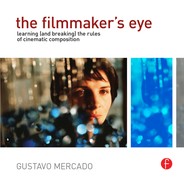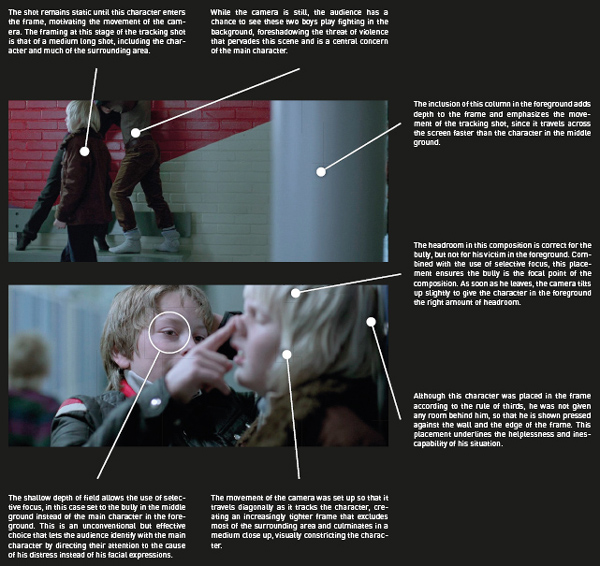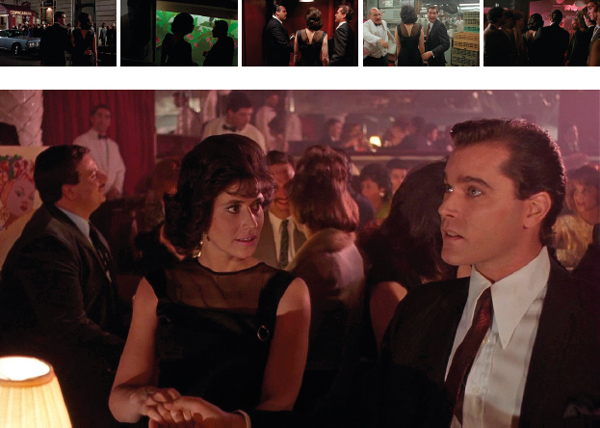tracking shot
In a tracking shot, the camera is moved to follow the movement of a subject along side it, in front of it (also called a reverse tracking shot, a Kubrick favorite), or behind it; because of this, the movement in tracking shots is said to be motivated. People often confuse tracking shots with dolly shots, but they are easy to tell apart, since in dolly shots the camera is moved independently of a subject (an unmotivated type of camera move), dollying towards or away from it, instead of tracking with a moving subject. Tracking shots can be accomplished by placing the camera on a dolly with wheels, or on tracks, with a Steadicam, inside a vehicle, or even handheld, depending on the amount and speed of the subject’s movement. Although tracking shots can come in almost any shot size, they are often taken using wider framings, such as medium shots, medium long shots, and long shots, since much of the dynamism of the composition is lost with tighter framings that would exclude most of the surrounding area. Tracking shots that move the camera sideways to follow a subject (a very common setup) have more dynamic compositions than tracking shots where the camera follows from behind or in front of a subject, since they emphasize movement along the x axis of the frame. Although less dynamic because they show movement along the z axis of the frame, reverse tracking shots have the advantage of letting the audience achieve a higher level of involvement with a character because they show the face of a subject from the front instead of in profile. Sometimes, tracking shots are combined with zoom shots or dolly in shots, so that as they follow a character the framing gets increasingly tighter, from a long shot or a medium long shot to a medium close up or a close up. These combinations can add tension and drama to a meaningful moment in a narrative, underlining the emotions of a character at the end of the shot. Tracking shots are also often long takes, especially when they are used to establish a relationship between a character and the surrounding area; this is often the case with reverse tracking shots, which tend to linger long enough to establish relevant details about a location and a character’s reactions as he or she moves through it.
A compelling use of a tracking shot is seen toward the end of François Truffaut’s masterpiece The 400 Blows (1959), the story of a neglected young Parisian adolescent, Antoine Doinel (Jean-Pierre Léaud), whose mischievous antics put him at odds with his family and eventually land him in a reformatory. Earlier in the film, he expressed his desire to see the ocean, having never seen it before; he soon manages to escape from the institution, only to run aimlessly through the countryside until he catches a glimpse of the coast. His run to freedom is captured in a tracking shot that lasts almost 80 seconds (an eternity in terms of shot length), revealing an emotionless Antoine in a long shot that lets us see the emptiness of his surroundings. The long take preserves the action in real time, dramatizing his escape and the broader impulse for flight (something Antoine does throughout the film), making this a pivotal act within the narrative as it leads the audience to one of the most famous freeze frames in the history of cinema.
A tracking shot stays with Antoine (Jean-Pierre Léaud) for almost 80 seconds as he runs away from a reformatory in François Truffaut’s marvelous examination of adolescent psychology, The 400 Blows (1959).
tracking shot
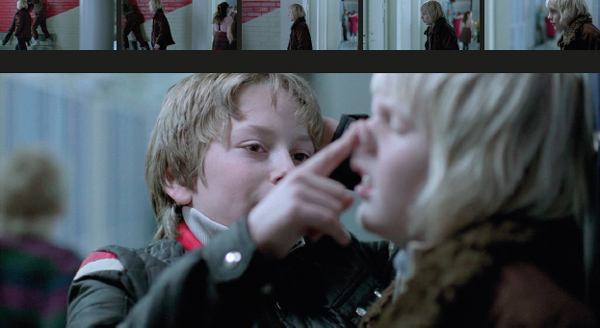
why it works
Tracking shots can be combined with other moving camera shots to further emphasize the importance of a moment in a scene. In this example from Tomas Alfredson’s Let the Right One In (2008), the story of the unlikely friendship that develops between Oskar (Kåre Hedebrant, pictured) a kid who is constantly bullied at school, and Eli (Lina Leandersson), a 200 year old vampire who has remained physically a 12 year old, a tracking shot is combined with a dolly in to underline Oskar’s anguish as he is accosted by a classmate. The actor and the camera were blocked so that as the camera tracks alongside him, it also gets closer to him, going from a medium long shot to a medium close up. The bully (Patrik Ridmark) is kept off-screen as Oskar retreats from him, entering the frame only as the tracking shot ends, conveying Oskar’s increasing sense of dread and impotence.
technical considerations
lenses
If the tracking shot moves alongside a character, your choice of focal length can have a major impact in the way movement across the x axis of the frame is perceived. For instance, if a telephoto lens is used, the field of view will be restricted considerably as the distances along the z axis of the frame are compressed. With this setup, even a relatively small sideways move of the camera will appear faster than normal, especially if a tighter framing (like a medium close up) is used to cover the action. If a wide angle lens is used instead, the field of view will be wider and distances along the z axis extended, making the background look farther away than it is in reality. Movement across the x axis will also appear to be slower than normal, since the background will not pass across the frame as quickly as when using a telephoto lens. When performing a handheld tracking shot, wide angle lenses and short camera to subject distances are commonly used, since they hide camera shake considerably. Remember, telephoto lenses will exaggerate any camera movement, and are usually recommended only when the camera is moved using a dolly, on tracks, with a vehicle, or with some stabilizing device like a Steadicam. Focusing can be problematic in a tracking shot, especially if a moving subject angles away from the camera, or when the shot combines sideways movement with a dolly in or out move, as seen in the example from Let the Right One In on the previous page. Since the camera to subject distance will not remain constant in these cases, a focus puller will have to assist to maintain sharp focus throughout the shot, after key distances have been measured and the shot choreographed and rehearsed a few times.
equipment
Using wheeled dollies can save a lot of time in the setup of tracking shots provided the surface over which they need to travel is even and smooth; otherwise, using a dolly that moves over tracks is an option, but keep in mind that it might take a long time to set the tracks up, especially if the terrain is very uneven. Other alternatives are to hand hold the camera, or use a Steadicam system or some other device for stabilization. It is important to remember that whenever the camera is handheld, the distance between it and the subject is likely to change throughout the shot, making it essential to find a way to adjust focus during a shot. This can be accomplished with a wireless focus pulling system, a camera assistant/focus puller using a follow focus attachment (although this is easier said than done), or by the camera operator herself, focusing not by manipulating the focusing ring on the lens, but by maintaining a constant camera to subject distance with the help of a large preview monitor attached to their camera rig. Another option to maintain sharp focus is to set up the tracking shot so that there is a relatively long distance between the camera and the subject (as seen in the example on the opposite page, from Florian Henckel von Donnersmarck’s 2006 film, The Lives of Others), but doing this will necessarily affect the composition of your shot.
lighting
Lighting can also be manipulated to make it easier to keep your subject in focus; for instance, you could add enough lights so that you can use a smaller aperture on the lens that gives you a deeper depth of field, allowing more room for the camera operator to move without throwing the subject out of focus. When shooting outdoors during the day, having enough light will not be a problem, unless a shallow depth of field is desired, which will require the use of a larger aperture on the lens. For this reason, any shooting done during the day outdoors should always include ND filtration, to control how much light will reach your film. Some SD and HD video cameras come equipped with ND filtration switches precisely for this purpose.
breaking the rules
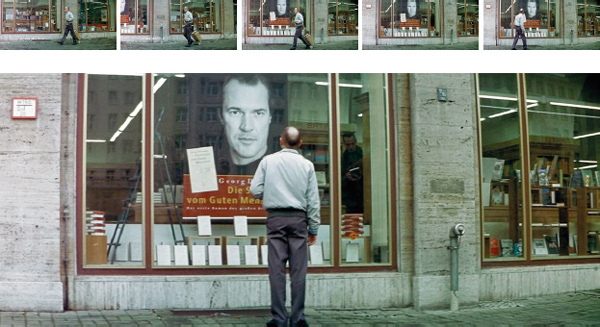
Tracking shots are motivated by the movement of characters in the frame, a convention designed to avoid camera movement that calls attention to itself. In this tracking shot from Florian Henckel von Donnersmarck’s The Lives of Others (2006), the camera follows Hauptmann Wiesler (Ulrich Mühe), a former Stasi (East Germany’s secret police) officer, some years after the fall of the Berlin wall. At one point during the tracking shot the camera stops, allowing him to leave the frame for a couple of seconds. This seemingly unmotivated action by the camera is jarring and unexpected, creating a moment of tension that lasts until the character steps back into the frame, as if suddenly realizing something; the shot ends as he stands in front of a large poster advertising a book by a counterrevolutionary playwright he spied on yet chose to protect rather than arrest.
Goodfellas. Martin Scorsese, 1990.
